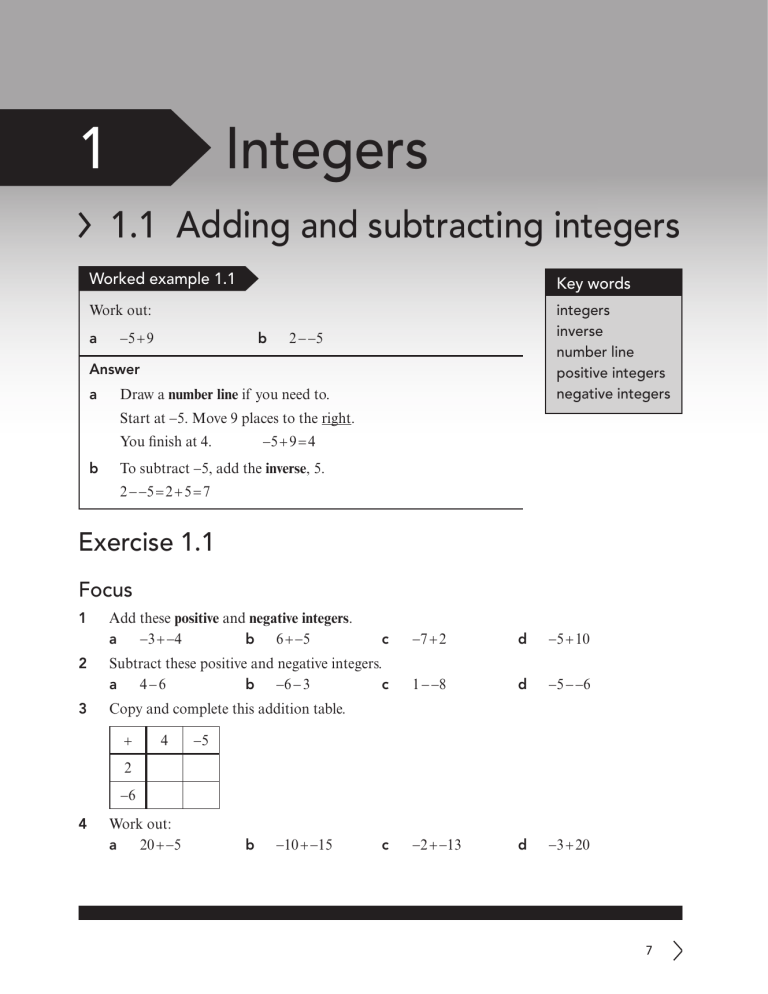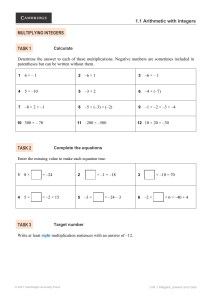
1 Integers 1.1 Adding and subtracting integers Worked example 1.1 Key words Work out: integers inverse number line positive integers negative integers a −5 + 9 b 2 − −5 Answer a Draw a number line if you need to. Start at −5. Move 9 places to the right. −5 + 9 = 4 You finish at 4. b To subtract −5, add the inverse, 5. 2 − −5 = 2 + 5 = 7 Exercise 1.1 Focus 1 2 3 Add these positive and negative integers. a −3 + −4 b 6 + −5 c −7 + 2 d −5 + 10 Subtract these positive and negative integers. a 4−6 b −6 − 3 c 1 − −8 d −5 − −6 −2 + −13 d −3 + 20 Copy and complete this addition table. + 4 −5 2 −6 4 Work out: a 20 + −5 b −10 + −15 c 7 1 Integers 5 Work out: a 20 − −5 c −2 − −13 Fill in the missing numbers. a 8+ =1 c −10 + = −6 b d −3 + =3 5+ = −5 Fill in the missing numbers. a −3=6 c − 3 = −1 b d −3=2 − 3 = −6 b −10 − −15 d −3 − 20 Practice 6 7 8 Estimate the answers to these questions by rounding the numbers to the nearest integer. −6.15 + 9.93 b 7.88 − −9.13 a −11.3 + −8.81 d 12.19 − 5.62 c 9 Estimate the answers to these questions by rounding the numbers. −28 − 53 b 514 + −321 a −888 − −111 d −61.1 + −29.3 c 10 Two integers add up to 2. One of the integers is 8. What is the other integer? 11 When you subtract one integer from another integer, the answer is 3. One integer is 1. Find the other integer. 12 Here are six integers: −5, −3, −2, 3, 4, 5. Use each integer once to complete these additions. a + =1 b + = −2 c + =3 Challenge 13 Copy and complete this addition table. + 3 5 −2 1 −6 14 This subtraction table shows that 3 − 6 = −3. Copy and complete the table. − 3 −3 8 −4 6 −3 1 1.2 Multiplying and dividing integers 15 Copy and complete these addition pyramids. a b 1 –3 –2 –4 4 6 –1 –6 16 This addition pyramid is more difficult than the pyramids in Question 13. Copy and complete the pyramid. Explain how you worked out the missing numbers. 5 3 1.2 Multiplying and dividing integers Worked example 1.2 Key word Work out: a 4 × −8 product b −20 ÷ (3 − −2) Answer a 4 × 8 = 32, so 4 × −8 = −32. b First, do the subtraction in the bracket. 3 − −2 = 3 + 2 = 5 So, −20 ÷ (3 − −2) = −20 ÷ 5 = −4. Exercise 1.2 Focus 1 2 Work out: a 10 × −3 b 4 × −9 c 5 × −11 d 7 × −7 Work out: a −24 ÷ 2 b −24 ÷ 6 c −50 ÷ 10 d −63 ÷ 9 9 1 Integers 3 Copy and complete this multiplication table. × 4 7 −2 −6 4 5 Work out: a (−5 + 2) × 4 c (1 − −3) × −7 b d (−6 + −4) × 3 (−2 − −5) × −10 Work out: a (−5 + −7) ÷ 4 c (6 − 14) ÷ 4 b d (−10 + −4) ÷ 2 (−5 − 13) ÷ 3 Work out the missing numbers. a 3× = −24 c −2 × = −26 b d 6× = −18 −12 × = −60 Work out the missing numbers. a −27 ÷ = −3 c ÷ 6 = −6 b d −36 ÷ = −9 ÷ 4 = −8 Practice 6 7 8 Estimate the answers to these questions by rounding the numbers. −4.1 × 2.8 b −7.1 × −3.2 a −1.1 × −7.9 d −9.1 ÷ 3.2 c 9 Estimate the answers to these questions by rounding the numbers. 423 × −2.9 b −32 × −28 a −6.1 × 219 d −612 ÷ 2.92 c 10 The product of 2 and −9 is −18. a Find three more pairs of integers with a product of −18. b Are there more pairs of integers with a product of −18? How can you be sure? 10 1.2 Multiplying and dividing integers 11 Copy and complete this multiplication grid. × 6 4 −30 −32 Challenge 12 In these diagrams, the integer in a square is the product of the integers in the circles next to it. a b –3 5 10 –2 6 i ii –2 –3 5 Copy each diagram and fill in the squares. Add the numbers in the squares in each diagram. 13 a This diagram is similar to the diagrams in Question 10. Copy and complete the diagram. All the numbers are integers. b Is there more than one solution? Have you found all of the solutions? –15 14 a b 15 a b c Use the integers 3, 4 and −5 to complete this calculation. ( + )× = −8 What is the largest answer you can get when you put the integers 2, −4 and 7 in this calculation? ( + )× Give evidence to explain your answer. –12 –8 –10 he product of two integers is −20. Find the largest possible value of the sum of the T two integers. The product of two integers is −30. Find the largest possible sum of the two integers. Can you generalise the result of part a and part b? 11 1 Integers 1.3 Lowest common multiples Worked example 1.3 Key words Find the lowest common multiple (LCM) of 6 and 9. common multiple lowest common multiple (LCM) multiple Answer The multiples of 6 are 6, 12, 18, 24, 30, 36, 42, 48, 54, … The multiples of 9 are 9, 18, 27, 36, 45, 54, … The common multiples are 18, 36, 54, … You may not need to list so many multiples each time. The lowest common multiple is 18. Exercise 1.3 Focus 1 Write down the first four multiples of: a 4 b 7 c d 12 2 How many multiples of 10 are less than 100? 3 a b c Work out the multiples of 8 that are less than 50. Work out the multiples of 5 that are less than 50. Write down the lowest common multiple of 8 and 5. 4 a b Find the first five common multiples of 2 and 3. Copy and complete this sentence: The common multiples of 2 and 3 are multiples of Find the lowest common multiple of 2 and 3. c 5 a b c 6 12 30 Write down the first three common multiples of 6 and 4. Copy and complete this sentence: The common multiples of 6 and 4 are multiples of Write down the lowest common multiple of 6 and 4. Find the lowest common multiple of: a 3 and 10 b 4 and 10 c 5 and 10 1.3 Lowest common multiples Practice 7 Show that the multiples of 3 and 5 are multiples of 15. 8 Find the lowest common multiple of 6 and 14. 9 a b c Find the lowest common multiple of: i 7 and 2 ii 7 and 4 iii 7 and 6 Is there an easy method to find the lowest common multiple of 7 and a number less than 7? Does the method in part b work for 7 and a number more than 7? 10 Look at these numbers: 90 92 94 96 98 100 a i Which number is a multiple of 9 and 10? ii Is this number the lowest common multiple? b i Which number is a multiple of 2 and 7? ii Is this number the lowest common multiple? c i Which number is a multiple of 12 and 8? ii Is this number the lowest common multiple? 11 Work out the lowest common multiple (LCM) of 2, 5 and 6. Challenge 12 Find the LCM of 3, 8 and 9. 13 24 × 4 = 96 a Explain why 96 is a common multiple of 4 and 24. b Is 96 the lowest common multiple of 4 and 24? Give evidence to justify your answer. 14 Two numbers have a LCM of 45. The two numbers add up to 14. Find the two numbers. 15 The LCM of two numbers is 63. Work out the two numbers. 13



